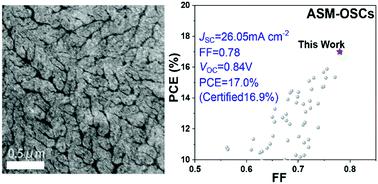当前位置:
X-MOL 学术
›
Energy Environ. Sci.
›
论文详情
Our official English website, www.x-mol.net, welcomes your feedback! (Note: you will need to create a separate account there.)
17% efficiency all-small-molecule organic solar cells enabled by nanoscale phase separation with a hierarchical branched structure
Energy & Environmental Science ( IF 32.5 ) Pub Date : 2021-09-27 , DOI: 10.1039/d1ee02124a Jinzhao Qin 1, 2 , Zhihao Chen 3 , Pengqing Bi 1 , Yang Yang 2, 4 , Jianqi Zhang 4 , Ziyun Huang 2, 4 , Zhixiang Wei 2, 4 , Cunbin An 1 , Huifeng Yao 1 , Xiaotao Hao 3 , Tao Zhang 1 , Yong Cui 1 , Ling Hong 1, 2 , Chenyu Liu 1, 2 , Yunfei Zu 1, 2 , Chang He 1 , Jianhui Hou 1, 2
Energy & Environmental Science ( IF 32.5 ) Pub Date : 2021-09-27 , DOI: 10.1039/d1ee02124a Jinzhao Qin 1, 2 , Zhihao Chen 3 , Pengqing Bi 1 , Yang Yang 2, 4 , Jianqi Zhang 4 , Ziyun Huang 2, 4 , Zhixiang Wei 2, 4 , Cunbin An 1 , Huifeng Yao 1 , Xiaotao Hao 3 , Tao Zhang 1 , Yong Cui 1 , Ling Hong 1, 2 , Chenyu Liu 1, 2 , Yunfei Zu 1, 2 , Chang He 1 , Jianhui Hou 1, 2
Affiliation

|
For all small-molecule-based organic solar cells (SM-OSCs), it is very challenging to obtain a nanoscale bicontinuous network structure in the active layers, so their power conversion efficiencies (PCEs) still lag behind those of the polymer-based OSCs. In this work, highly efficient SM-OSCs based on a ternary bulk heterojunction (BHJ) layer of B1:BO-2Cl:BO-4Cl were constructed. Ternary cells with the three different BO-2Cl:BO-4Cl weight ratios exhibit higher PCEs than those of B1:BO-2Cl- and B1:BO-4Cl-based binary cells. The results obtained from the transient absorption, time-resolved photoluminescence spectroscopy and device physics analysis reveal that the ternary cell with the optimal composition (B1:BO-2Cl:BO-4Cl = 1 : 0.5 : 0.5 in weight ratio) exhibits faster charge transfer processes, suppressed geminate and non-geminate charge recombination, lower energetic disorder, and higher and more symmetric carrier mobilities than the two binary cells. The transmission electron microscopy measurement results reveal that the nanoscale bicontinuous interpenetrating network with a hierarchical branched structure can be fully evolved in the BHJ layer with the optimal ternary composition. As a result, the optimal ternary cell exhibits a PCE of 17.0% (certified to be 16.9%) and a fill factor of 0.78, which are the highest values obtained for SM-OSCs.
中文翻译:

通过具有分层分支结构的纳米级相分离实现 17% 效率的全小分子有机太阳能电池
对于所有基于小分子的有机太阳能电池 (SM-OSC),在活性层中获得纳米级双连续网络结构非常具有挑战性,因此它们的功率转换效率 (PCE) 仍然落后于基于聚合物的 OSC . 在这项工作中,构建了基于 B1:BO-2Cl:BO-4Cl 三元体异质结 (BHJ) 层的高效 SM-OSC。具有三种不同 BO-2Cl:BO-4Cl 重量比的三元电池表现出比基于 B1:BO-2Cl 和 B1:BO-4Cl 的二元电池更高的 PCE。从瞬态吸收、时间分辨光致发光光谱和器件物理分析获得的结果表明,具有最佳组成(B1:BO-2Cl:BO-4Cl = 1 : 0.5 : 0.5 重量比)的三元电池表现出更快的电荷转移流程,与两个二元电池相比,双晶和非双晶电荷重组受到抑制,能量紊乱更低,载流子迁移率更高且更对称。透射电子显微镜测量结果表明,具有分级分支结构的纳米级双连续互穿网络可以在具有最佳三元组成的 BHJ 层中完全演化。因此,最佳三元电池的 PCE 为 17.0%(经认证为 16.9%),填充因子为 0.78,这是 SM-OSC 获得的最高值。透射电子显微镜测量结果表明,具有分级分支结构的纳米级双连续互穿网络可以在具有最佳三元组成的 BHJ 层中完全演化。因此,最佳三元电池的 PCE 为 17.0%(经认证为 16.9%),填充因子为 0.78,这是 SM-OSC 获得的最高值。透射电子显微镜测量结果表明,具有分级分支结构的纳米级双连续互穿网络可以在具有最佳三元组成的 BHJ 层中完全演化。因此,最佳三元电池的 PCE 为 17.0%(经认证为 16.9%),填充因子为 0.78,这是 SM-OSC 获得的最高值。
更新日期:2021-09-27
中文翻译:

通过具有分层分支结构的纳米级相分离实现 17% 效率的全小分子有机太阳能电池
对于所有基于小分子的有机太阳能电池 (SM-OSC),在活性层中获得纳米级双连续网络结构非常具有挑战性,因此它们的功率转换效率 (PCE) 仍然落后于基于聚合物的 OSC . 在这项工作中,构建了基于 B1:BO-2Cl:BO-4Cl 三元体异质结 (BHJ) 层的高效 SM-OSC。具有三种不同 BO-2Cl:BO-4Cl 重量比的三元电池表现出比基于 B1:BO-2Cl 和 B1:BO-4Cl 的二元电池更高的 PCE。从瞬态吸收、时间分辨光致发光光谱和器件物理分析获得的结果表明,具有最佳组成(B1:BO-2Cl:BO-4Cl = 1 : 0.5 : 0.5 重量比)的三元电池表现出更快的电荷转移流程,与两个二元电池相比,双晶和非双晶电荷重组受到抑制,能量紊乱更低,载流子迁移率更高且更对称。透射电子显微镜测量结果表明,具有分级分支结构的纳米级双连续互穿网络可以在具有最佳三元组成的 BHJ 层中完全演化。因此,最佳三元电池的 PCE 为 17.0%(经认证为 16.9%),填充因子为 0.78,这是 SM-OSC 获得的最高值。透射电子显微镜测量结果表明,具有分级分支结构的纳米级双连续互穿网络可以在具有最佳三元组成的 BHJ 层中完全演化。因此,最佳三元电池的 PCE 为 17.0%(经认证为 16.9%),填充因子为 0.78,这是 SM-OSC 获得的最高值。透射电子显微镜测量结果表明,具有分级分支结构的纳米级双连续互穿网络可以在具有最佳三元组成的 BHJ 层中完全演化。因此,最佳三元电池的 PCE 为 17.0%(经认证为 16.9%),填充因子为 0.78,这是 SM-OSC 获得的最高值。



























 京公网安备 11010802027423号
京公网安备 11010802027423号